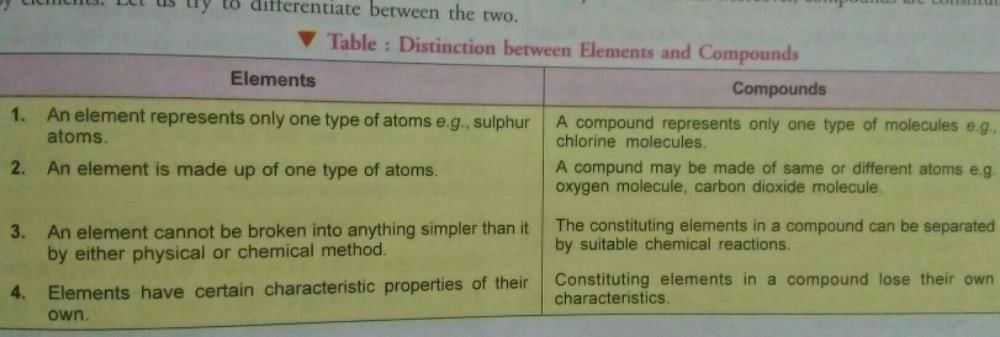Class 9 Exam > Class 9 Questions > What is differences between elements and comp...
Start Learning for Free
What is differences between elements and compound?
Most Upvoted Answer
What is differences between elements and compound?

Community Answer
What is differences between elements and compound?
Differences between Elements and Compounds
Definition
Elements: An element is a substance that cannot be broken down into simpler substances by chemical means. Elements are made up of only one type of atoms.
Compound: A compound is a substance made up of two or more elements chemically combined in a fixed proportion. Compounds can be broken down into simpler substances by chemical means.
Composition
Elements: Elements are made up of only one type of atoms, which have the same number of protons in their nuclei. This means that all atoms of a particular element have the same atomic number.
Compound: Compounds are made up of two or more elements that are chemically combined in a fixed proportion. The elements in a compound are held together by chemical bonds.
Properties
Elements: The properties of an element depend on the number of protons in its nucleus, which determines its atomic number. Elements have unique physical and chemical properties that distinguish them from other elements.
Compound: The properties of a compound are different from those of the elements that make it up. The properties of a compound depend on the chemical bonds between the elements and the way in which they are arranged.
Representation
Elements: Elements are represented by symbols, which are usually one or two letters. For example, the symbol for hydrogen is H and the symbol for carbon is C.
Compound: Compounds are represented by chemical formulas, which show the elements and the number of atoms of each element in the compound. For example, the formula for water is H2O, which means that it is made up of two hydrogen atoms and one oxygen atom.
Conclusion
Elements and compounds are two different types of substances. Elements are made up of only one type of atom, while compounds are made up of two or more elements that are chemically combined. The properties of elements and compounds are different, and they are represented differently. Understanding the differences between elements and compounds is important in chemistry and science in general.

|
Explore Courses for Class 9 exam
|

|
Question Description
What is differences between elements and compound? for Class 9 2025 is part of Class 9 preparation. The Question and answers have been prepared according to the Class 9 exam syllabus. Information about What is differences between elements and compound? covers all topics & solutions for Class 9 2025 Exam. Find important definitions, questions, meanings, examples, exercises and tests below for What is differences between elements and compound?.
What is differences between elements and compound? for Class 9 2025 is part of Class 9 preparation. The Question and answers have been prepared according to the Class 9 exam syllabus. Information about What is differences between elements and compound? covers all topics & solutions for Class 9 2025 Exam. Find important definitions, questions, meanings, examples, exercises and tests below for What is differences between elements and compound?.
Solutions for What is differences between elements and compound? in English & in Hindi are available as part of our courses for Class 9.
Download more important topics, notes, lectures and mock test series for Class 9 Exam by signing up for free.
Here you can find the meaning of What is differences between elements and compound? defined & explained in the simplest way possible. Besides giving the explanation of
What is differences between elements and compound?, a detailed solution for What is differences between elements and compound? has been provided alongside types of What is differences between elements and compound? theory, EduRev gives you an
ample number of questions to practice What is differences between elements and compound? tests, examples and also practice Class 9 tests.

|
Explore Courses for Class 9 exam
|

|
Signup for Free!
Signup to see your scores go up within 7 days! Learn & Practice with 1000+ FREE Notes, Videos & Tests.
























